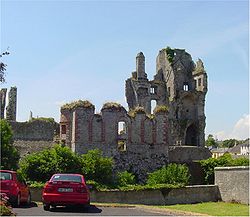Askeaton Castle
| Askeaton Castle | |
|
County Limerick | |
|---|---|
 Askeaton Castle | |
| Location | |
| Grid reference: | R34075028 |
| Location: | 52°36’0"N, 8°58’26"W |
| Village: | Askeaton |
| History | |
| Built 1199 | |
| Information | |
| Condition: | Partly restored |
| Owned by: | Heritage Ireland |
Askeaton Castle otherwise known as Desmond Castle stands on a rocky island on the River Deel at the heart of the wee town of Askeaton in County Limerick, and forming its focal point.
This castle has protected Askeaton since 1199. Over the centuries, the castle proved itself key to the history of Munster. It was the power base of the Earls of Desmond after 1348, and in 1579 the castle held out against Queen Elizabeth's general Sir Nicholas Malby, an incident that helped spark the second Desmond Rebellion.
The banqueting hall is one of the finest medieval secular buildings in Ireland. The tower is partly ruined, but some fine windows and an exquisite medieval fireplace have remained.
History
William de Burgo is noted as the builder of the castle. The castle and its rights were given to Hamo de Valoignes, the Justiciary of Ireland between 1197 and 1199. In the Annals of Inisfallen, William de Burgo is recorded as having been granted the castle and estates by the king of Thomand, Dónal Mór.
in 1348 Maurice FitzGerald, 1st Earl of Desmond paid 40 shillings for the barony of Lystifti. The building that stands today dates from that time. The Earls of Desmond were to become a powerful presence in Munster, of whom it was proudly said that they had become 'more Irish than the Irish themselves' – they lived in the Gaelic manner, following the Brehon Laws, dressed in the Irish manner, spoke Irish, played Irish music and games, rode and hunted, and respected poets.
The family had generations of enmity with the MacCarthys to the south in Cork and Kerry, as well as with their bitter Anglo-Norman rivals, the Butlers, Earls of Ormond.
The earliest written reference to the castle appears in Leabhar nanCeart, in English The Book of Rights, compiled in the 15th century, in which the fort of Gephtine is mentioned as being reserved to the King of Cashel.
The Earls of Desmond, the FitzGeralds, held possession of the castle for over 200 years; it was the centre of their power, and they ruled Munster from it. The tragic Gerald FitzGerald, 14th Earl of Desmond, known as The Rebel Earl, had a powerful stronghold at Askeaton in 1559.
The reassertion of Royal authority in the wilder areas of Ireland led to a rebellion by the Irish lords across Munster. Gerald, The Rebel Earl, was popular among his followers, but as the atrocities of the war grew unbearable they gradually abandoned him. Fleeing with a few retainers, on 11 November 1583 he was murdered by Moriarty of Castledrum, at Glenagenty, five miles east of Tralee at Bóthar an Iarlaigh.[1]
Sir Nicholas Malby unsuccessfully attacked the castle in 1579: Askeaton Castle was at that time occupied by Lieutenant Patrick Purcell of the Confederate Catholics. The English saw Askeaton as a threat while it was held by the Confederate rebels. It was destroyed by the Cromwellian captain Daniel Axtell in 1652; he hanged Patrick Purcell. (Axtell had been captain of the Parliamentary Guard at the trial of King Charles I at Westminster Hall in 1649 and shortly after the Restoration in 1660 he himself was hanged, drawn and quartered as a regicide.)
After the capture of Askeaton, Lord Justice Sir William Pelham then took possession, and this marked the end of the FitzGerald reign over Askeaton and Munster.
The castle was transferred to the ownership of the Crown under Captain Edward Berkley.[2]
The early eighteenth-century building nearby was used as a Hellfire Club.
Outside links
| ("Wikimedia Commons" has material about Askeaton Castle) |
- Askeaton Castle: Heritage Ireland
References
- ↑ Rowan, A. B. (1872). "The Last Geraldyn Chief of Tralee Castle". In Hickson, Mary Agnes. Selections from Old Kerry Records; Historical and Genealogical. London: Watson & Hazell. pp. 117–130. Originally published Kerry Magazine. May 1854.
- ↑ (Taken from a lecture by Anita Guinane, (Askeaton Civic Trust)
